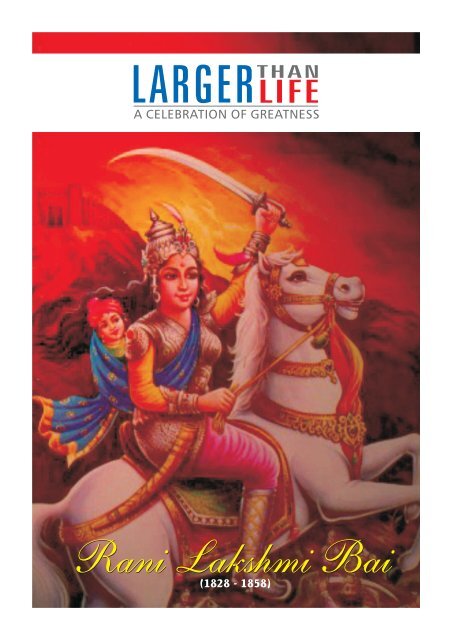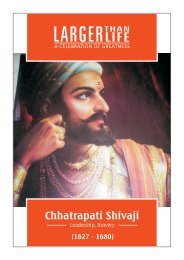Rani Lakshmi Bai.cdr - The Fifth Veda Entrepreneurs
Rani Lakshmi Bai.cdr - The Fifth Veda Entrepreneurs
Rani Lakshmi Bai.cdr - The Fifth Veda Entrepreneurs
You also want an ePaper? Increase the reach of your titles
YUMPU automatically turns print PDFs into web optimized ePapers that Google loves.
<strong>Rani</strong> <strong>Lakshmi</strong> <strong>Bai</strong><br />
<strong>Rani</strong> <strong>Lakshmi</strong> <strong>Bai</strong><br />
(1828 - 1858)
<strong>Rani</strong> <strong>Lakshmi</strong> <strong>Bai</strong><br />
(1828 - 1858)<br />
Introduction<br />
<strong>Lakshmi</strong> <strong>Bai</strong>, <strong>The</strong> <strong>Rani</strong> of Jhansi was the queen of the Maratha-ruled princely state<br />
of Jhansi in North India. She was one of the leading figures of the Indian<br />
rebellion of 1857, and a symbol of resistance to British rule in India. She was the<br />
embodiment of patriotism, self-respect and heroism. She was the queen of a small state,<br />
but the empress of a limitless empire of glory.<br />
Early Life<br />
<strong>Lakshmi</strong> <strong>Bai</strong> was a Maharashtrian Brahmin born sometime around 1828 at Kashi<br />
(presently known as Varanasi).Mannikarnika (Manu) was the name of <strong>Rani</strong> <strong>Lakshmi</strong> <strong>Bai</strong><br />
in her childhood. Manu lost her mother at the age of four. <strong>The</strong> complete responsibility of<br />
the young girl fell on the father. She completed her education and also learned horse<br />
riding, sword fighting and shooting.<br />
She was married to Raja Gangadhar Rao , the Maharaja of Jhansi in 1842, and<br />
became the queen of Jhansi. After their marriage, she was given the name<br />
<strong>Lakshmi</strong> <strong>Bai</strong>. In 1853 Gangadhar Rao fell very ill and he was persuaded to adopt<br />
a child. To ensure that the British would not be able to contest the adoption, the <strong>Rani</strong><br />
had it witnessed by the local British representatives. Maharaja Gangadhar Rao expired<br />
the following day. After the death of Maharaja Gangadhar Rao, she was left alone.<br />
But she did not lose her courage. She always remembered her responsibility.<br />
Annexation<br />
At that time Lord Dalhousie was the Governor-General of India. Though little<br />
Damodar Rao, adopted son of late Maharaja Gangadhar Rao and <strong>Rani</strong> <strong>Lakshmi</strong> <strong>Bai</strong> was<br />
Maharaja's heir and successor as per the Hindu tradition, the British rulers rejected<br />
<strong>Rani</strong>'s claim that Damodar Rao was their legal heir. Under the Doctrine of Lapse,<br />
Lord Dalhousie decided to annex the state of Jhansi as Maharaja Gangadhar Rao had<br />
left no legal heir.
<strong>The</strong> War<br />
<strong>Rani</strong> Jhansi was determined not to give up Jhansi. She proclaimed her decision<br />
with the famous words :Mi mahji Jhansi nahi dehnar (I will not give up my<br />
Jhansi).She strengthened the defense of Jhansi and she assembled a volunteer army<br />
of rebellions. Women were recruited as well as men and given military training. <strong>Rani</strong><br />
was accompanied by her generals. Many from the local population volunteered for<br />
service in the army ranks, with the popular support for her cause on the rise.<br />
<strong>The</strong> Britishers attacked Jhansi in March 1858. <strong>Rani</strong> Jhansi with her faithful warriors<br />
decided not to surrender. <strong>The</strong> fighting continued for about two weeks. Shelling on<br />
Jhansi was very fierce. In the Jhansi army, women were also carrying ammunition and<br />
were supplying food to the soldiers. <strong>Rani</strong> <strong>Lakshmi</strong> <strong>Bai</strong> was very active. She herself was<br />
inspecting the defense of the city. However, after this Great War, Jhansi fell to the British<br />
forces.<br />
On that black day, the British army entered the Jhansi City. <strong>Rani</strong> <strong>Lakshmi</strong> <strong>Bai</strong>, still full<br />
of courage and deathless patriotism dressed as a man, took up arms, her son<br />
Damodar Rao was strapped tightly to her back. She was holding the reins of her<br />
horse in her mouth. In the fierce fighting she was using the sword with both her<br />
hands. When the situation was not in control, <strong>Rani</strong> of Jhansi with some of her<br />
warriors departed from Jhansi.<br />
Later Years<br />
<strong>Rani</strong> <strong>Lakshmi</strong> <strong>Bai</strong> reached Kalpi. Many other rebellions force joined her. Tantya Tope<br />
from Kalpi was also one of them. From Kalpi <strong>Rani</strong> departed to the Gwalior. Again a<br />
fierce battle took place. <strong>Rani</strong> Jhansi fought with deathless patriotism and<br />
martyrdom. However on the second day of fighting, the great heroine of the first<br />
struggle for India freedom, in 1858, at the age of 30 years, lost her life. Because of<br />
her unprecedented bravery, courage and wisdom and her progressive views on<br />
women's empowerment in 19th century India, and due to her sacrifices, she became an<br />
icon of Indian Nationalist Movement.






